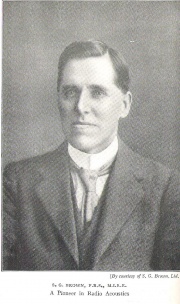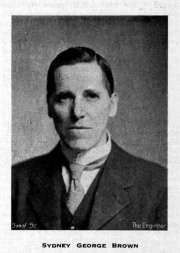Difference between revisions of "Sidney George Brown"
(Added a photograph of the subject when a bit younger) |
|||
| Line 1: | Line 1: | ||
[[image:IM1928SGBrown.jpg|thumb|1928]] | |||
[[image:Im1948v186-p163.jpg|thumb| 1948.]] | [[image:Im1948v186-p163.jpg|thumb| 1948.]] | ||
Revision as of 19:22, 18 November 2016
Sidney George Brown (1873-1948), electrical engineer and inventor,
1873 Born in Chicago, USA, on 6 July. He was the eldest son of English parents.
1879 The family returned to England and Brown was privately educated at a school in Parkstone, near Bournemouth, and subsequently educated at Harrogate College, Yorkshire, followed by University College, London.
1892-1897 He was a paying pupil at Crompton's electrical engineering works in Chelmsford. After completion, he was employed for a further six months by Cromptons. His father became ill so he had to return to the family business in Bournemouth.
1899 He continued to work at his electrical interests and patented the first of many inventions for improving telegraph cables. At about the same time he was assisting Sir Henry Hozier, secretary of Lloyds, to develop a radio telegraph system.
1906 He formed the Telegraph Condenser Co to manufacture and market his inventions.
1908 Brown married and his wife, Alice Mary Herbert Russell, took a keen interest in his work. In later years she was largely responsible for the administration and financial control of his companies.
1910/11 He formed a new company, S. G. Brown Ltd, to manufacture telephone equipment. With his wife's assistance, he designed a telephone relay, an improved receiver, and an effective loudspeaker (the Browns being first to use this name for the device). He had a small workshop in Houndsditch for the manufacture of the type 'A' reed headphone which became famous throughout the world.
1914 His businesses had expanded to employ over a thousand people. At the outbreak of war, there was no British manufacturer of gyro compasses, which had been imported from Germany. Brown set out to remedy the deficiency. During this work also devised a new method of damping the oscillation set up in a compass by a change in course called ‘liquid ballistic control’.
1916 Brown served as a member of the Admiralty's inventions board during the First World War. Already a member of the Institution of Electrical Engineers and a fellow of the Institute of Physics, he was elected a fellow of the Royal Society.
1943 Brown retired and sold his interest in the Telegraph Condenser Co to a syndicate, and S. G. Brown Ltd to the Admiralty. In retirement, he devoted time mainly to cultivating orchids.
1948 He died at his home, Brownlands, Salcombe Regis, Sidmouth, Devon, on 7 August, survived by his wife.
1948 Obituary.[1]
SIDNEY GEORGE BROWN, F.R.S., who died at Sidmouth on the 7th August, 1948, was born at Chicago on the 6th July, 1873. He was educated at Harrogate College and at University College, London, and served his apprenticeship with Crompton and Co. at Chelmsford. For many years he directed the affairs of S. G. Brown, Ltd., and of the Telegraph Condenser Co., combining with technical knowledge and engineering experience remarkable ability as a designer.
In 1899 he patented the drum-cable relay, and in 1910, the reed-type telephone receiver, which, in the days of crystal detectors, enabled signals to be read that were otherwise inaudible. He next worked on various designs of relays for the magnification of feeble signals in radio and line telephony, notably the microphone relay. With the introduction of broadcasting, his organization was one of the first to undertake the mass production of headphones, and, although he produced many types of horn loudspeakers, he had foreseen the development of the enlarged-cone type as early as 1910, when he referred to it in drawing up his patent specifications for reed receivers. The greatest of all his inventions was his gyro compass.
He joined The Institution as an Associate Member in 1899 and was elected a Member in 1905. His papers on "Automatic Relay Translation for Long Submarine Cables" and "A Telephone Relay" were published in the Journal in 1902 and 1910; for each of these he was awarded a Fahie Premium. His papers on loudspeakers were published in the Journal in 1924 and 1929.
1948 Obituary [2]
"ANOTHER link with the early days of communication by telegraphy and radio was broken on Saturday, August 7th, when Mr. Sydney George Brown, F .R .S., M.I.E .E:, died, at the age of seventy-five, at his home, " Brownlancts," Sidmouth , after a long illness. An electrical engineer by profession, he was, perhaps, best known as an inventor and as the founder and one-time chairman of the Telegraph Condenser Company, Ltd., and of S. G. Brown, Ltd., Acton. By his originality, his flair for translating ideas into practice and his prolific output, he was substantially responsible for many of the advances of his day in communication by cable, line and radio.
Sydney George Brown, the eldest son of Sydney Brown, of Bournemouth, was born at Chicago on July 6, 1873. He was educated in England, first at Harrogate College and then at University College, London. At the outset of his career he was attracted to the problem of increasing the speed of signalling along submarine cables for economic working. He quickly achieved the first step towards a solution by developing a practical form of cable relay, and in 1899 he patented his drum cable relay. '"The effectiveness of this device was enhanced by a complementary development, the magnetic shunt, which helped to clarify the attenuated signals at the end of a long cable. Improved forms of relays were devised, the effect of stray earth currents on the terminal instruments was minimised and Brown's system for relaying signals over long submarine cable proved itself to be a practical proposition in the intensely competitive field of long-distance communication...[more]"



